|

|
Maritime Topics On Stamps :
Viking Boats!
|
Viking boats are part of the history of the scandinavian
countries of Denmark, Norway and Sweden.
They were built from the 7th to 11th century.
|

|
This stamp shows a picture chiselled into a rock roundabout 1000 B.C. You can see a
small boat which can be called the predecessor of the early viking boats. In those
days the boats had a only wooden frame covered with animal skins. Later on these skins
were replaced by wooden planks. Characteristic mark of this viking boat is the double
stem. In 1921 such a boat was discovered on the Danish island Alsen, later called the
'Hjortspring' boat. The length of the boat was 13m, breadth 2m and it had 16 paddles.
|
The typical viking boat had a pointed bow and an equally pointed stern, rising high
above the waterline and having nearly the same form. The keel was shallow and the planks
were constructed slightly overlapping - the so called 'clinker' structure shown on the
stamp below.
The vikings utilized mainly oaks and spruces to construct their boats. To the right you
can see Norman craftsmen at work, cutting planks from trees and fixing them
to their boats. This picture was taken from a carpet in the cathedral of Bayeux,
Normandy, France.
|

|
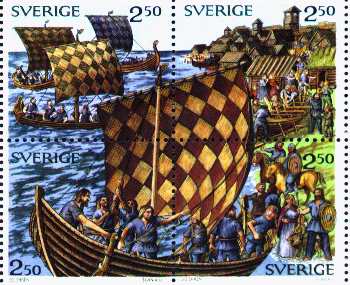
|
Below the waterline the planks were only bound to the ribs to provide optimum
elasticity for the boat. Spruce roots were cut and twisted to make the ropes. Above the
waterline the conventional method of riveting with wooden or iron nails took over.
To finish the planks were sealed with tarred animal hair.
All sailing boats had a relative short mast - the height did not top 10 meters. To
counter the low height the yards were constructed with a width ranging from 12 to 15
meters.
All Sails were rectangular and made of double-weaved wool or linen. To strengthen the
sail an extra net was sown on top. This net often had a coloured pattern consisting of
red squares or stripes. In wet conditions the sails became very heavy and reduced the
stability of the boat.
| |
The vikings developed an excellent helm. It was a short, thick oar, fixed to a wooden
block by a rope at the right side of the ship. The helm could be used like a lever around
its fulcrum. The helmsman operated it with the help of a tiller. For this reason the
right side of a ship is called starboard (coming from "steering board") up to today.
|
As for all other seagoing vessels, different types of viking boats were developed
during the course of time, mainly merchantmen and man of wars. The dragon boats
('Drakars'), the longboats ('Skuders') and small support boats ('Karvis') all belonged
to the latter class. The merchantmen or 'high seas boats' ('Hafskips') consisted of
the types 'Knorr' and 'Byrdingr'. Sometimes the term 'longboat' was used for merchantmen
as well.
The small rowing-boats were called 'Batrs', but since the 7th century all greater boats
had a mast with a sail. When the crew was rowing or fighting the mast was turned down.
Nevertheless there were still some boats being built without a mast.
|

|
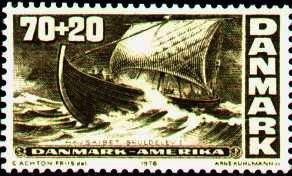
|
Here are some numbers for the merchantmen type 'Knorr' or 'Knarr':
Length 16m, breadth 4 to 5m, one sail, 3 or 4 pairs of oars at bow and stern for
manouevering the boat. They were able to load 15 tons of freight and
in good winds these boats could reach a speed of up to 8 knots. They were used
for discovery and emigration voyages as well as on the typical merchant routes.
The 'Knorr' was the standard 'high seas' ship of the vikings. To the left you can see
the 'Skuldelev' boat No.1, dug out in the Danish Roskilde Fjord in 1957. This is a
typical 'Knorr' design.
| |
The merchantmen type 'Byrdingr' was smaller than the 'Knorr' type, with a length of max.
12 meters. They operated mainly in the Baltic Sea and some authors simply call them
'Baltic Sea Knorr'.
The entire Swedish stamp block shown above depicts boats of the 'Byrdingr' type.
|
|
The great man of wars were called dragon ships ('Drakar'/'Dreki').
A dragon ship was the flagship of a king or chieftain.
The length went up to 48 meters, breadth 7 to 8m, 70 to 80 oars. The huge sail
had a width of up to 21m. The crew consisted of up to 300 warriors, who were used to
manouevre the boat by rowing as well.
In contrast to other types these ships had a relative high free board to provide cover
for the warriors during battle. One of the most famous dragon boats was the 'Ormen Lange'
of king Olaf Tryggvason, dated 998 A.C.
On the stamp to the right you can see a man of war enduring a heavy storm.
|

|
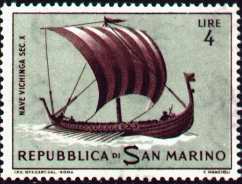
|
The other man of war type was the classical longboat divided into two sub-classes,
called 'Skuder', 'Skaid' or 'Skeidh' with up to 60 oars and 'Snigge', 'Snekja' or
'Schnigge' with up to 40 oars.
The measures: length 30m, breadth 6m, draught 0.8m, crew members 200,
mast height 9m, sail width up to 15 meters. Under full sail the ships
could reach 11 knots, Norwegian sources say 20 knots and more!
The small draught allowed the boats to navigate rivers and
other shallow waters. It was easy to pull the boats onto a beach and to travel a short
stretch across open country with them by the use of wooden rolls.
This stamp shows the elegant form of a longboat.
|

|

|
On a man of war both bow and stern were decorated by ornamental carvings. Dragon heads
were the most common designs, closely followed by bulls, snakes and worms ('Ormen Lange'
(see above) means 'the long worm'). In viking legends dragons used to blew fire through
their nostrils and so the purpose of these terrible decorations was to frighten and
cause horror in the hearts of the enemies. On the left stamp you can see a great
dragon head. Funnily most of the dragon heads were removable and stowed away, when
coming home, as they could upset the ghosts ...
The stern and the sides of the boats were decorated as well. Often the shields of the
warriors were hang over the rail. On top of the masts were mounted small wind direction
finders in form of beautiful birds.
On the stamp above you can see a viking boat on a stone from the 8th century.
This stone was found on the Swedish island of Gotland and you can distinguish sail,
warriors, their shields, the helm and the decorations.
|
|
The term 'viking' is not the name of a nation or a particular tribe but an occupation.
The old north word 'vikingr' means 'men going to sea for robbery' or short 'pirates'.
The Franconians called them 'Normans'. During those times small viking war expeditions
robbed the coasts of both the North and Baltic Seas.
The vikings were brutal plunderers and conquerors. Huge war expeditions with
excellently prepared attacks and great fleets were conducted against the British Islands
and the territories of France.
On the stamp you can see a viking warrior, armed with shield and sword, war axe, clad
in chainmail and wearing a helmet (without horns!) - the standard equipment. During an
attack they used spears and bows as well.
The vikings made only for a small part of the scandinavian population. Most people were
settlers, merchants and, of course, excellent shipbuilders.
|

|

|

| |
The vikings fought also among each other. The Conquest of the British Island by the Normans is
but one example. The armies of Harold Godwinson and the earl William of the Normandiy fought a
bloody battle in 1066 at Hastings. Harold derived from a long line of Danish and Swedish
kings. William derived from the Norwegian chieftain Rollo. He had helped the childless
British king Edward before and was promised the British throne in return.
The warriors of William went ashore in southern England and won the day against Harold's
troops. The history of the battle at Hastings was woven in epic pictures into the famous
Bayeux carpet, which has a length of 70 meters. You can see a set of 6 stamps from Jersey
with pictures of this carpet, just as some French and UK stamps. This carpet was the
model for the design for a lot of stamps from all around the world.
|
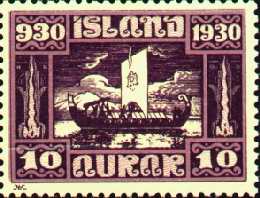
|
Round about 860 A.C. the first vikings arrived on the shores of Iceland. They were
murderers and outcasts, living on the Foroyars and driven off by a storm.
During the course of time the island got several names like 'Snowland', 'Gardarsholm' and
finally 'Iceland'. On the stamp you can see the boat of Ingolf Arnarson.
At the bow some of his men throw the posts of his 'high-chair' into the sea, as this was
a usual custom. According to tradition the place the posts reached the shore was the best
area for settlement. And this happened to be the 'smoking bay', Reykjavik, today the capital
of Iceland. 150 years later (1010) Iceland already had a population of 60.000 people.
|
|
The vikings accomplished great achievements in the fields of navigation and seamenship.
It is amazing how they managed to cross the North Atlantic using only simple
navigational aid (without a compass) and in constant struggle against heavy storms.
Despite the circumstances the passage quickly became a routine job for the sailors.
Normally the journey started at South Norway, crossing to the Shetlands, then via the
Foroyar to Icleand. The distance is 730 nautical miles and most boats covered it in 5 to 6
days. A 'saga' told about a voyage in a record time, 4 days and nights. If this is true,
the boat must have reached an average speed of 7.5 knots!
|
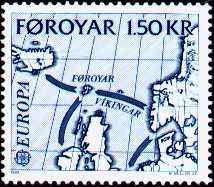
|
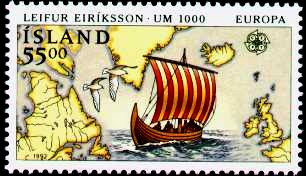
|
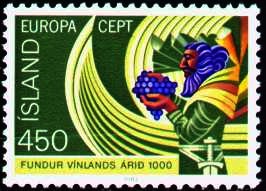
| |
Eric, the Red was outcast for cruelty against his neighbours. The ban was limited to 3 years,
but during this time he discovered 'Greenland' (Gronland) and settled there. His son was
the famous Leif Eriksson, In the year 986 Bjarni Herjolfsson discovered America by accident,
as storm drift pushed him more westward as he planned to go.
In 1001 Leif Eriksson sailed to America, using the reports of Bjarni and went ashore
at the coast of what is today Newfoundland. There he found berries and called the
country 'Vinland' (Wineland). These 'bunch of grapes' kept generations of historians
confused, because they actually didn't grow in Newfoundland. Leif's landing point was
located and relocated several times at different places between Miami and Newfoundland.
The vikings tried to settle Vinland, but they gave up after a few years, because of
continuous, tiring wars against the natives.
On the left stamp you can see Leif's 'Knorr' boat heading southwest for Newfoundland.
To the right the symbolic bunch of grapes. In reality they were supposed to be
squashberries, mossberries or red currants.
|
|